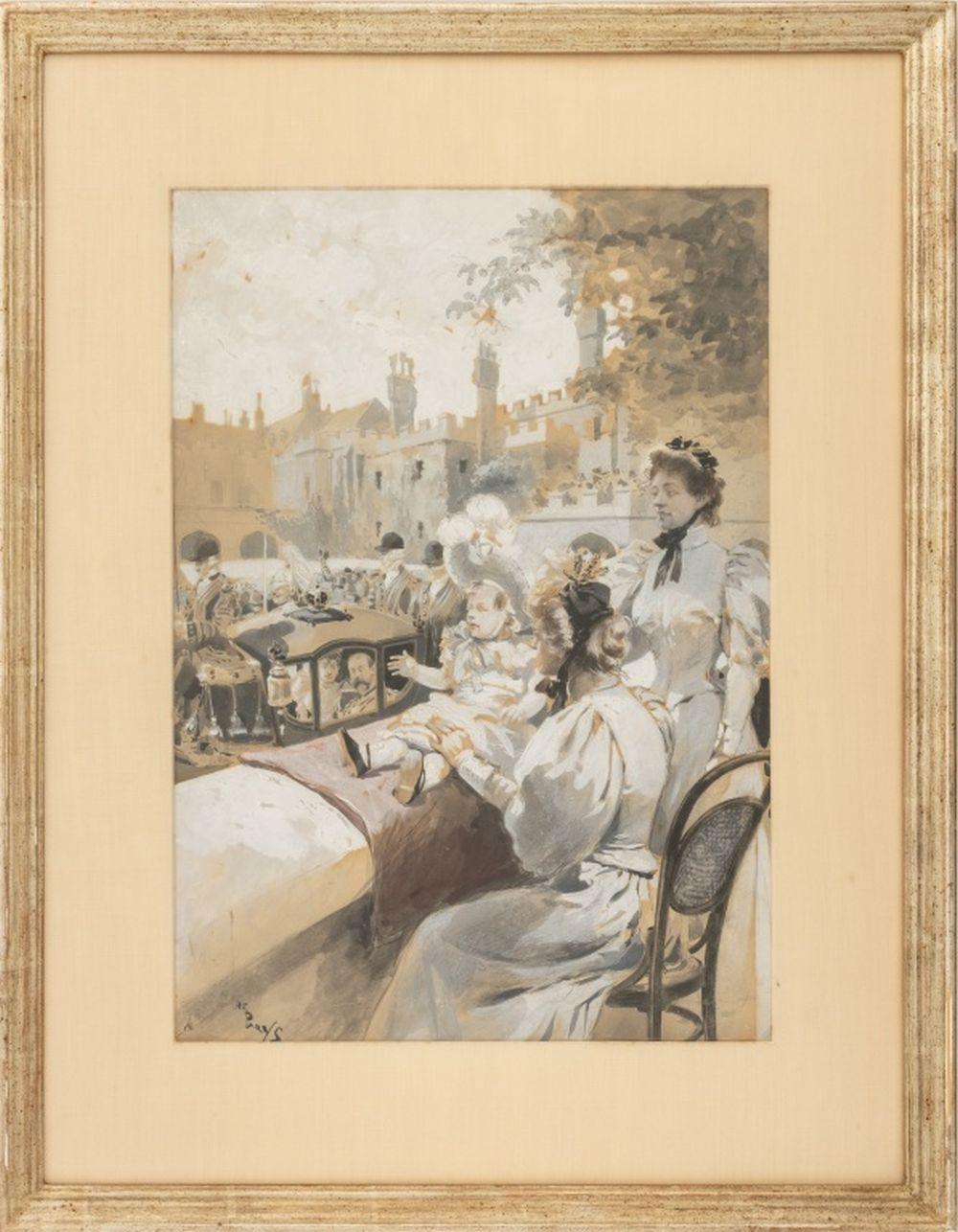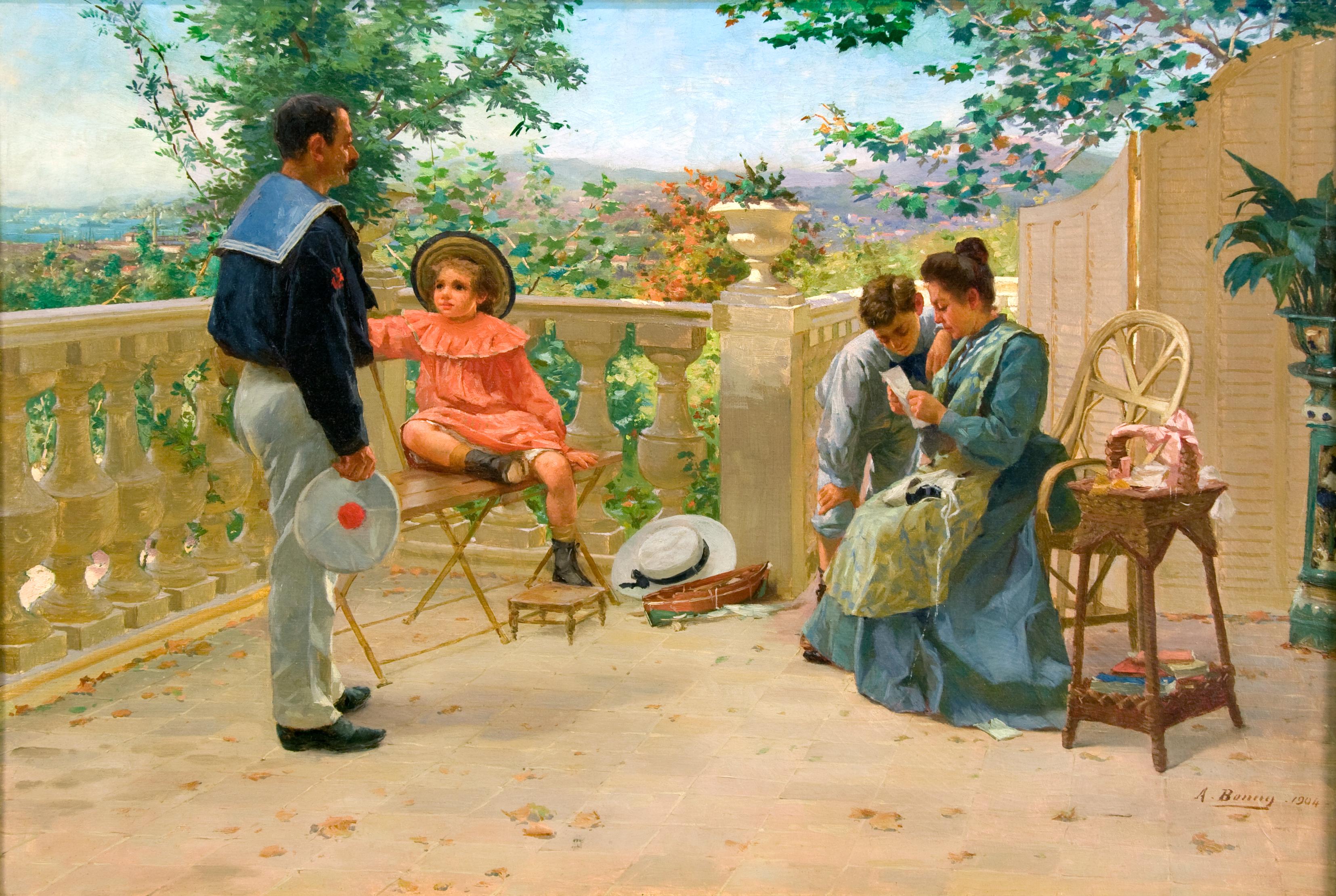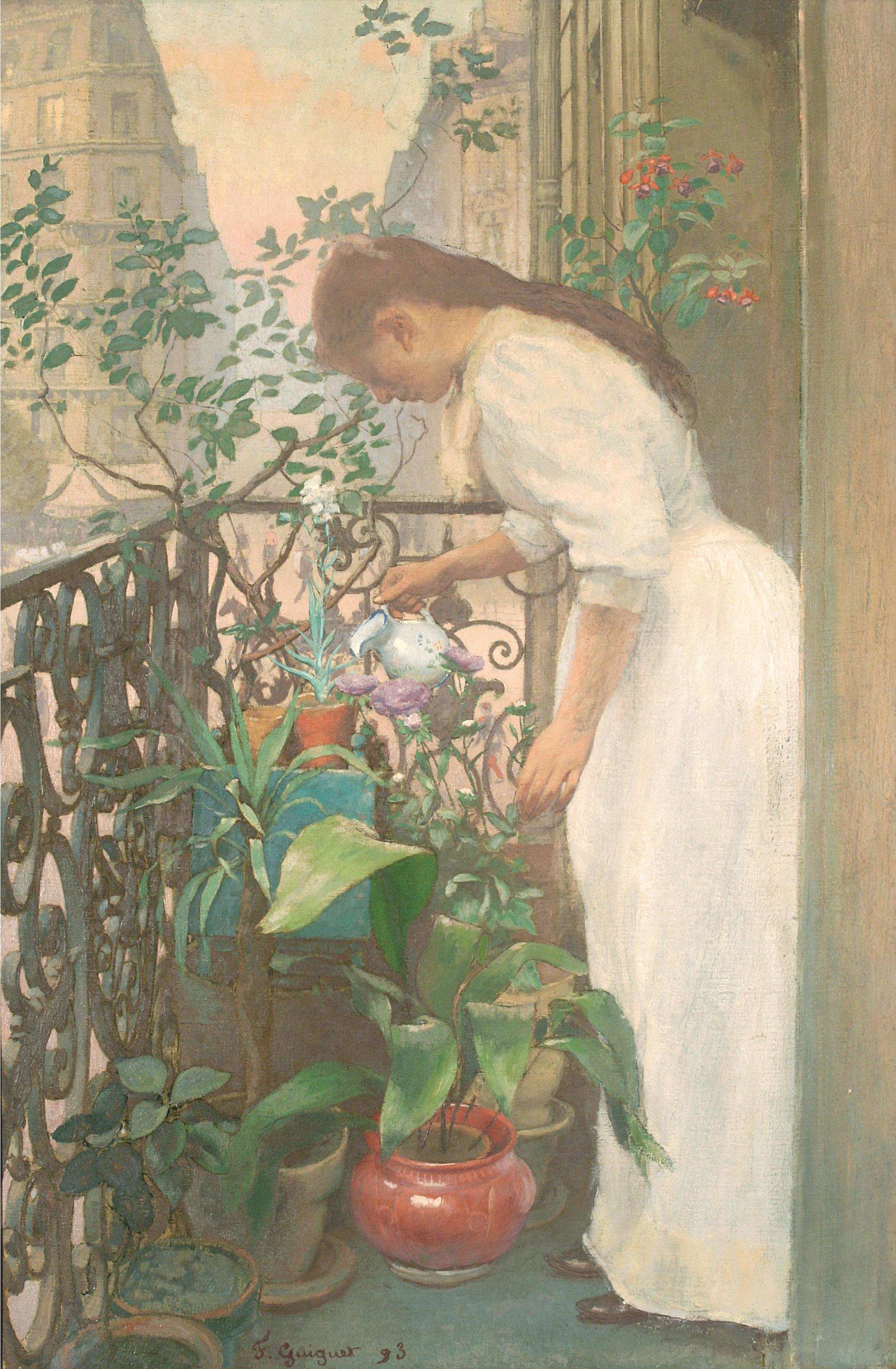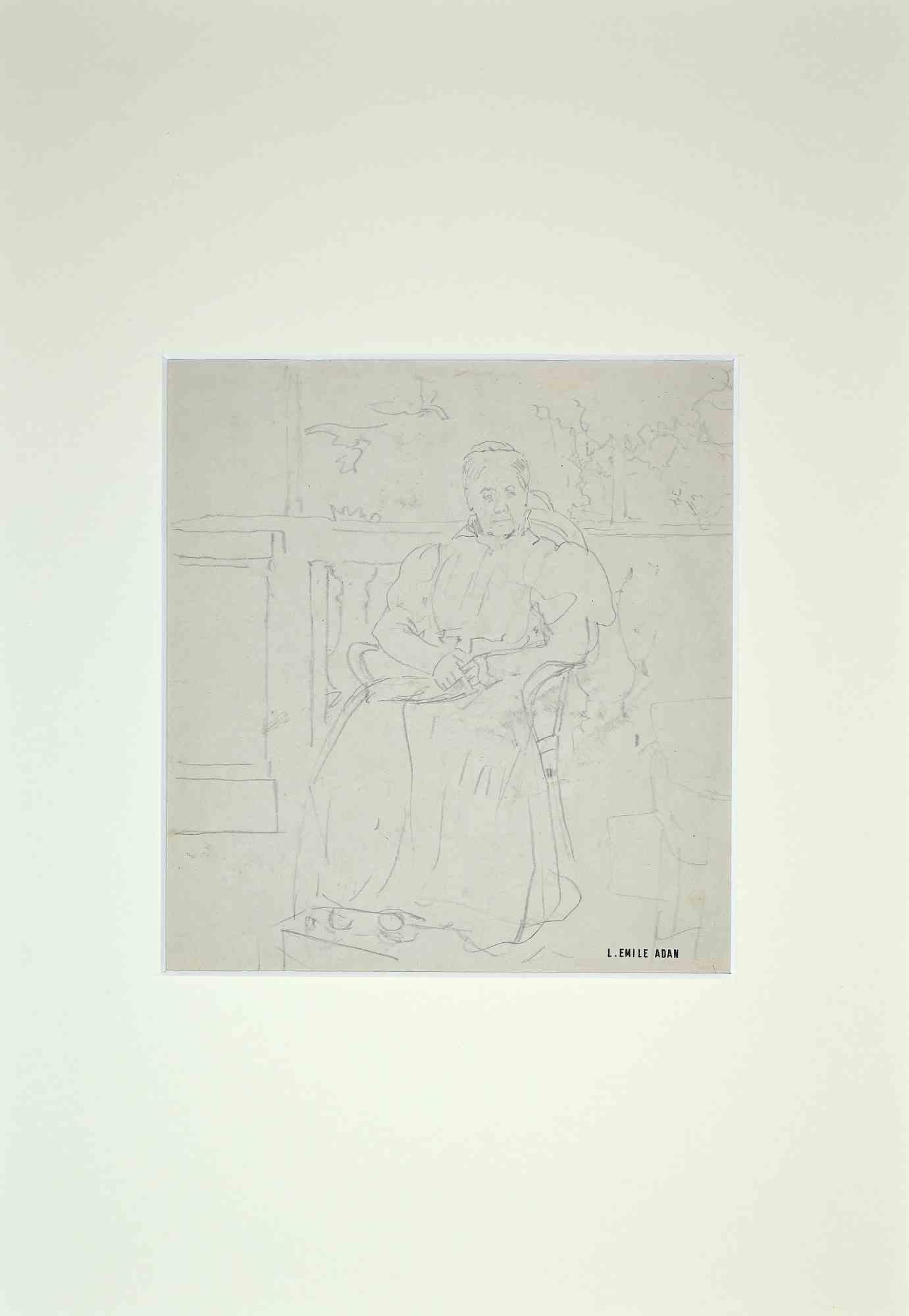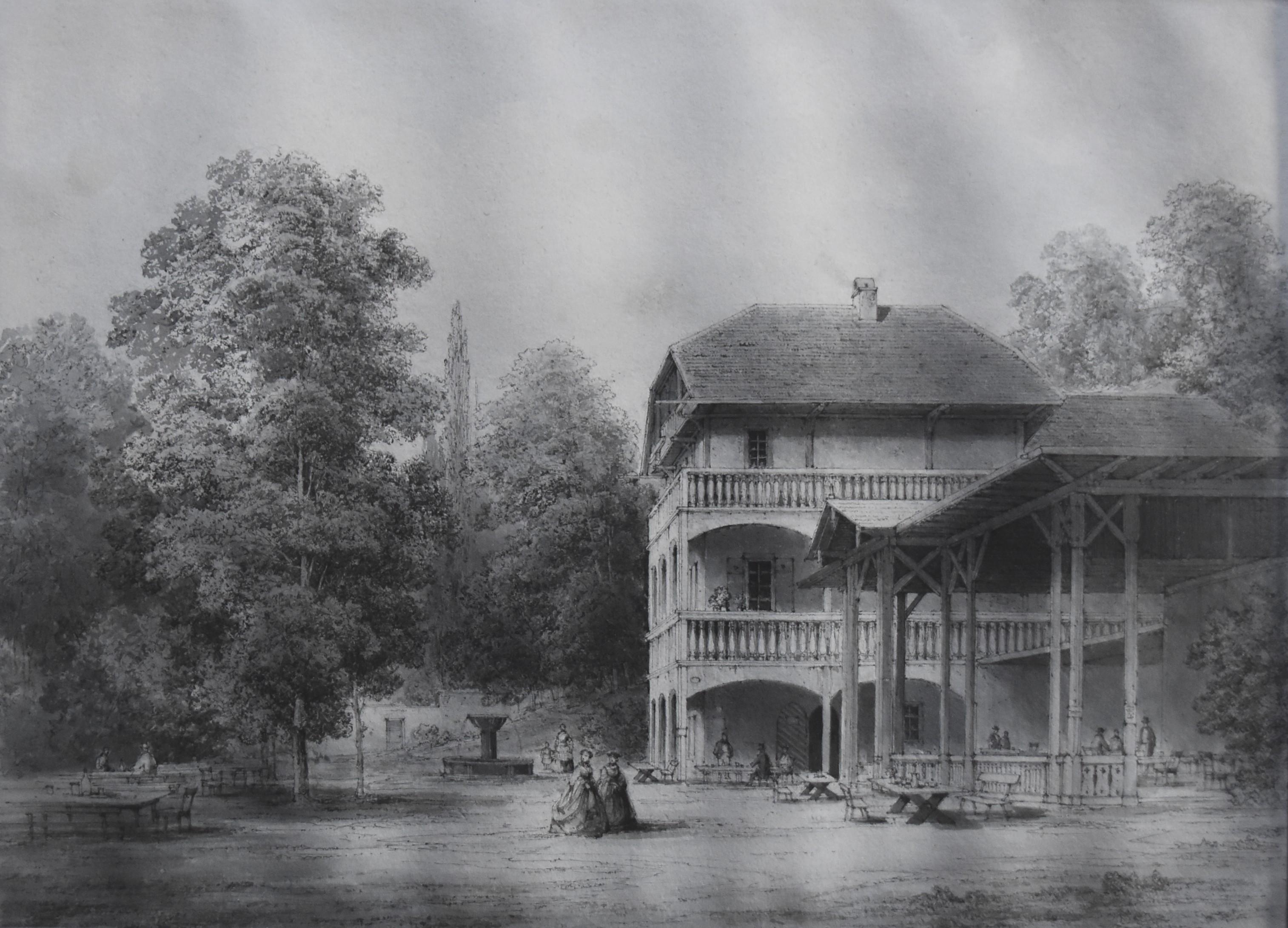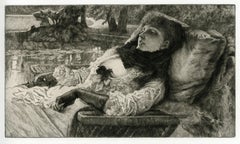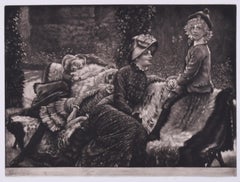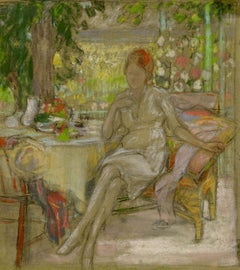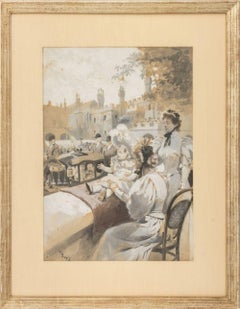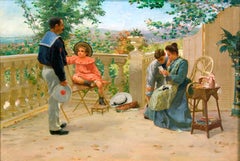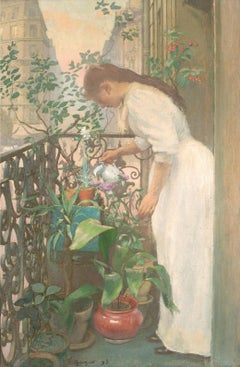Items Similar to La Terrasse de la Villa Brancas, Sevres (The Terrace of the Villa Brancas)
Want more images or videos?
Request additional images or videos from the seller
1 of 10
Félix BracquemondLa Terrasse de la Villa Brancas, Sevres (The Terrace of the Villa Brancas)1876
1876
$2,000
£1,527.80
€1,755.29
CA$2,859.57
A$3,150.58
CHF 1,630.93
MX$37,933.80
NOK 20,651.53
SEK 19,400.81
DKK 13,106.59
About the Item
La Terrasse de la Villa Brancas, Sevres (The Terrace of the Villa Brancas)
etching & drypoint, 1876
Signed in the plate bottom right corner (see photo)
in plate, at lower left: xbre / 1876 [underlined]
A proof of State vii/VIII, before the addition of the inscription "L'Art" in the plate lower right corner. Very rare in any of the pre publication states
The etching depicts the terrasse of a villa overlooking the Seine valley, opposite the old factory and the heights of Bellevue.
"Bracquemond here represents his wife Marie painting her sister outdoors on the terrace of their villa at Sevres. The print was published in the periodical L'Art in 1879, the year that both Marie and Félix exhibited with the Impressionists." Courtesy MMA
Condition: Very good
Some staining consistent with being a working proof impression, prior to the published state
Image size: 10 1/16 x 13 15/16 inches
Sheet (irregular) 11 3/16 x 15 inches
Reference:
Beraldi 215, between vii and viii, prior to the inscription "L'Art" in the plate
IFF iii.381.377
"French engraver, painter, and decorator of ceramics. He is best known for his many etchings, both original and reproductions of famous paintings. Bracquemond was a chief founder of the influential Society of Painter-Engravers, established in France in 1889. Félix Bracquemond (1833 in Paris - 1914 in Sèvres) was a French impressionist painter and etcher. He was trained in early youth as a trade lithographer, until Guichard, a pupil of Ingres, took him to his studio. His portrait of his grandmother, painted by him at the age of nineteen, attracted Theophile Gautier's attention at the Salon. He applied himself to engraving and etching about 1853, and played a leading and brilliant part in the revival of the etcher's art in France. Altogether he produced over eight hundred plates, comprising portraits, landscapes, scenes of contemporary life, and bird-studies, besides numerous interpretations of other artist's paintings, especially those of Jean-Louis-Ernest Meissonier, Gustave Moreau and Jean-Baptiste Camille Corot. After having been attached to the Sèvres porcelain factory in 1870, he accepted a post as art manager of the Paris atelier of the firm of Haviland of Limoges. He was connected by a link of firm friendship with Édouard Manet, James McNeill Whistler, and all the other fighters in the impressionist cause, and received all the honors that await the successful artist in France, including the grade of officer of the Legion of Honor in 1889."
Courtesy Barnett Gallery
"In 1874, French printmaker Félix Bracquemond (1833-1914) submitted more works than any other artist to the inaugural impressionist exhibition. The work Bracquemond displayed—at his friend Edgar Degas’s invitation—included portraits of his artistic contemporaries, naturalistic landscapes, reproductive etchings of historical European paintings, and emblematic images of birds accompanied by poems (such as Margot the Critique, or The Magpie).
Bracquemond and each of the more than 50 members of the impressionist cooperative possessed varied aesthetic goals, sharing only a determination toward artistic independence from the State-sponsored annual Salon. Today, however, major exhibitions tend to pigeonhole Impressionism as landscapes and informal portraiture by select artists, namely Claude Monet, Pierre-Auguste Renoir, Berthe Morisot, and/or Camille Pissarro. Whether for that reason or the fact that Bracquemond himself did not identify closely with the label “impressionist,” the artist’s work is often not considered alongside that of his impressionist contemporaries. The special exhibition Félix Bracquemond: Impressionist Innovator (on view Feb 14 –Oct 4, 2015) reintroduces this independent-minded artist through a selection of more than eighty works on paper and tableware objects, including his most imaginative and groundbreaking reinterpretations of French art and decorative arts traditions.
Plate (Rooster, Frog, and Flower) from the Service Rousseau, 1866-76, Félix Bracquemond, glazed earthenware, Gift of Frank Raysor, 2013.506
“Plate (Rooster, Frog, and Flower)” from the Service Rousseau, 1866-76, Félix Bracquemond, glazed earthenware, Gift of Frank Raysor, 2013.506
After learning etching through self-directed study, Bracquemond emerged as a leader of the Etching Revival in France. In 1863, he co-founded the Société des Aquafortistes (Society of Etchers) with enterprising publisher Alfred Cadart and fellow printmakers, whose goal was to rekindle interest in original etchings among artists and the public alike. VMFA’s exhibition includes a frontispiece that Bracquemond produced for one of the group’s albums—portfolios made available by subscription—as well as original compositions published by arts journal that promoted these experimental “painter-printmakers.”
Bracquemond’s distinctive bird imagery—well-represented in the exhibition—often reflects his taste for Japanese art. A pioneer of Japanese-inspired compositions who had procured a volume of Hokusai’s Manga (translated as “Random Sketches”) as early as 1856, Bracquemond next built his reputation as a decorative arts innovator by infusing ceramic designs with motifs adapted from Japanese print sources. The Service Rousseau, which features birds, fish, insects, and flowers that he borrowed from Manga, helped propel the popularity of Japonisme throughout France. Bracquemond briefly served as artistic director at Sèvres porcelain factory before assuming that role for Haviland Limoges porcelain manufactory until 1881. Despite these successful forays into ceramics, Bracquemond remained dedicated to exploring the vast aesthetic possibilities of the print making process into the early 20th century."
Courtesy VMFA
- Creator:Félix Bracquemond (1883 - 1914, French)
- Creation Year:1876
- Dimensions:Height: 10.07 in (25.58 cm)Width: 13.94 in (35.41 cm)
- Medium:
- Movement & Style:
- Period:
- Condition:
- Gallery Location:Fairlawn, OH
- Reference Number:Seller: FA109541stDibs: LU14014663622
Félix Bracquemond
Fe´lix Bracquemond was born in Paris. He was trained in early youth as a trade lithographer, until Guichard, a pupil of Ingres, took him to his studio. His portrait of his grandmother, painted by him at the age of nineteen, attracted The´ophile Gautier's attention at the Salon. He applied himself to engraving and etching about 1853, and played a leading and brilliant part in the revival of the etcher's art in France. Altogether he produced over eight hundred plates, comprising portraits, landscapes, scenes of contemporary life, and bird-studies, besides numerous interpretations of other artist's paintings, especially those of Jean-Louis-Ernest Meissonier, Gustave Moreau and Jean-Baptiste-Camille Corot. After having been attached to the Se`vres porcelain factory in 1870, he accepted a post as art manager of the Paris atelier of the firm of Haviland of Limoges. He was connected by a link of firm friendship with E´douard Manet, James McNeill Whistler, and all the other fighters in the impressionist cause, and received all the honors that await the successful artist in France, including the grade of Officer of the Legion of Honor in 1889. Bracquemond was a prominent figure in artistic and literary circles in the second half of the 19th century. He was close to writers such as Edmond de Goncourt and critic Gustave Geffroy, and numbered among his friends Millet and Corot, Henri Fantin-Latour, Degas and the Impressionist circle, and Auguste Rodin. He was one of the more prolific printmakers of his time and he was awarded the grande medaille d'honneur at the Universal Exhibition of 1900. He was also a painter, ceramist, and an innovator in decorative arts. Gabriel Weisberg called him the "molder of artistic taste in his time". Indeed, it was he who recognised the beauty of the Hokusai woodcuts used as packing around a shipment of Japanese china, a discovery which helped change the look of late 19th-century art. He married French Impressionist artist Marie Bracquemond in 1869. He died in Se`vres.
About the Seller
5.0
Recognized Seller
These prestigious sellers are industry leaders and represent the highest echelon for item quality and design.
Platinum Seller
Premium sellers with a 4.7+ rating and 24-hour response times
Established in 1978
1stDibs seller since 2013
815 sales on 1stDibs
Typical response time: <1 hour
Associations
International Fine Print Dealers Association
- ShippingRetrieving quote...Shipping from: Akron, OH
- Return Policy
Authenticity Guarantee
In the unlikely event there’s an issue with an item’s authenticity, contact us within 1 year for a full refund. DetailsMoney-Back Guarantee
If your item is not as described, is damaged in transit, or does not arrive, contact us within 7 days for a full refund. Details24-Hour Cancellation
You have a 24-hour grace period in which to reconsider your purchase, with no questions asked.Vetted Professional Sellers
Our world-class sellers must adhere to strict standards for service and quality, maintaining the integrity of our listings.Price-Match Guarantee
If you find that a seller listed the same item for a lower price elsewhere, we’ll match it.Trusted Global Delivery
Our best-in-class carrier network provides specialized shipping options worldwide, including custom delivery.More From This Seller
View AllSoirée d'été (Summer Evening)
By James Jacques Joseph Tissot
Located in Fairlawn, OH
Soirée d'été (Summer Evening)
Etching & drypoint, 1881
Signed and dated in the plate lower left corner
Edition: c. 100 in both states; plate canceled
Tissot's lover, Irish divorcee ...
Category
1880s Impressionist Portrait Prints
Materials
Etching
Au Bois De Boulogne (illustrating the congregation of French nobility outside
Located in Fairlawn, OH
Au Bois De Boulogne (illustrating the congregation of French nobility outside the Chalets du Cycle
Chromolithograph, 1897
Signed in the plate lower right corner
From the Special Supp...
Category
1890s Art Nouveau Figurative Prints
Materials
Lithograph
Le banc de jardin (The Garden Bench)
By James Jacques Joseph Tissot
Located in Fairlawn, OH
Le banc de jardin (The Garden Bench)
Mezzotint and engraving on cream chine collé laid down on ivory wove paper, 1883
Signed in the plate (see photo)
Condition: Brilliant impression...
Category
1880s Impressionist Figurative Prints
Materials
Mezzotint
Woman on a Patio
By Karl Albert Buehr
Located in Fairlawn, OH
Woman on a Patio
Pastel on paper, c. 1915
Unsigned
Provenance: Gift of the artist to his wife, Mary Hess Buehr
By decent to the artist's niece, daughter of Will...
Category
1910s Abstract Impressionist Figurative Drawings and Watercolors
Materials
Pastel
Woman on a Patio
By Karl Albert Buehr
Located in Fairlawn, OH
Woman on a Patio
Pastel on paper, c. 1915
Unsigned
Provenance: Gift of the artist to his wife, Mary Hess Buehr
By decent to the artist's niece, daughter of Will Hess
David Saltzman
Robert Henry Adams Fine Art
Thomas French Fine Art
Ronald C. Sloter, Columbus, Ohio
Columbus College of Art and Design (de-accessed)
Exhibited at Robert Henry Adams Fine Art, 1994, the first exhibition at the North Franklin Street Gallery.
One of the early Chicago artists to adopt Impressionism, Karl Buehr became a figure and landscape painter. As a figure painter, his specialty became "gorgeously colored images of young women on porches overlooking brilliant summertime gardens." (Kennedy 98) His later work often showed a female figure with serious expression engaging the viewer with a direct stare. In his landscapes, he was noted for his strong coloration. In a December 1896 student exhibition at the Art Institute, a reviewer for the "Chicago Times Herald" described Buehr's landscapes as "blithe and joyous" with "country roads brilliant in sunlight . . . fields rich in summer verdure, under soft skies painted in a high, musical key." (Gerdts 68)
Buehr was born as one of seven sons to a prosperous German family who immigrated to America and settled in Chicago in 1869. He was first exposed to his signature style of Impressionism in 1888 when he enrolled in night classes at the Art Institute while working in the shipping department of a lithographic firm near the Institute. He remained a student there until 1897 and was recognized in a "Chicago Times Herald" editorial of June 13, 1897 as one of the Institute's most outstanding pupils.
The next year, his art career was temporarily put on hold when he briefly enlisted with the U.S. Army in the Spanish American War. In 1899, he resumed his art studies, this time with Frank Duveneck. He exhibited a painting at the Paris Salon of 1900. In 1905, thanks to a wealthy Chicago patron, Buehr and his family moved to France. They spent the following year in Taormina, Sicily, and spent time in Venice as well. In Paris, Buehr studied at the Academy Julian with Raphael Collin for two years. Then he went to England, enrolling in the London Art School but had returned to Paris by 1908. During this time, he began painting at Giverny, the home of Impressionist leader Claude Monet (1840-1926, and by 1912, Buehr was listing that village as his home address. One of his good friends and associates at Giverny was Frederick Frieseke.
One of Buehr's paintings from that time, "News from Home", was exhibited in 1913 at the French Salon in Paris and at the annual exhibit of the Chicago Art Institute. It shows a woman in floral dress sitting on a porch with a background with potted flowers and lush greenery background. Of his painting done at Giverny, Buehr wrote in 1912 to William Macbeth of Macbeth Galleries in New York: "My figures painted in and around Giverny are costumed and in appropriate out door settings." (Gerdts 68)
In 1914, he returned to the United States and took a teaching position in Chicago at the Art Institute, which he held for the remainder of his life. He was married to Mary Hess, a painter of miniatures and decorative works.
In 1928-29, he was a guest artist at Stanford University.
Courtesy, AskArt
“Karl Albert Buehr (1866–1952) was a painter born in Germany.
Buehr was born in Feuerbach - near Stuttgart. He was the son of Frederick Buehr and Henrietta Doh (Dohna?). He moved to Chicago with his parents and siblings in the 1880s. In Chicago, young Karl worked at various jobs until he was employed by a lithograph company near the Art Institute of Chicago. Introduced to art at work, Karl paid regular visits to the Art Institute, where he found part-time employment, enabling him to enroll in night classes. Later, working at the Institute as a night watchman, he had a unique opportunity to study the masters and actually posted sketchings that blended in favorably with student's work. Having studied under John H. Vanderpoel, Buehr graduated with honors, while his work aroused such admiration that he was offered a teaching post there, which he maintained for many years thereafter. He graduated from the Art Inst. of Chicago and served in the IL Cav in the Spanish–American War. Mary Hess became Karl's wife—she was a student of his and an accomplished artist in her own right. In 1922, he was elected into the National Academy of Design as an Associate member.
Art Studies in Europe
In 1904, Buehr received a bronze medal at the St. Louis Universal Exposition, then, in 1905, Buehr and his family moved to France, thanks to a wealthy Chicago patron, and they spent the following year in Taormina, Sicily, where the artist painted local subjects, executing both genre subjects and landscapes as well as time in Venice. Buehr spent at least some time in Paris, where he worked with Raphaël Collin at the Académie Julian.
Giverny and American Impressionism
Prior to this time, Buehr had developed a quasi-impressionistic style, but after 1909, when he began spending summers near Monet in Giverny, his work became decidedly characteristic of that plein-air style but he began focusing on female subjects posed out-of-doors. He remained for some time in Giverny, and here he became well-acquainted with other well known expatriate America impressionists such as Richard Miller, Theodore Earl Butler, Frederick Frieseke, and Lawton Parker. It seems likely that Buehr met Monet, since his own daughter Kathleen and Monet’s granddaughter, Lili Butler, were playmates, according to George Buehr, the painter’s son. His other daughter Lydia died before adulthood due to diabetes. He returned to Chicago at the onset of World War I and taught at The Art Inst for many years. One of his noted pupils at the Art Institute was Archibald Motley...
Category
1910s Abstract Impressionist Figurative Drawings and Watercolors
Materials
Pastel
Le Tasse de The (The Cup of Tea)
By Manuel Robbe
Located in Fairlawn, OH
Le Tasse de The (The Cup of Tea)
Color aquatint and etching, c. 1906
Signed in pencil in the image (see photo)
Edition: c. 100
Reference: Merrill Chase, Volume 1, No. 85
Condition: F...
Category
Early 1900s Art Nouveau Figurative Prints
Materials
Aquatint
You May Also Like
Figural Courtyard Landscape Scene
Located in Astoria, NY
Louis Van Parys (French, d. 1896), Figural Courtyard Landscape Scene, Gouache, Aquarelle, and Pencil on Paper, signed "A d Parys" lower left, silvered wood frame. Image: 18.5" H x 12...
Category
19th Century French School Figurative Drawings and Watercolors
Materials
Paper, Watercolor, Gouache
La Lecture de la lettre sur la terrasse
Located in Mc Lean, VA
Genre painting with Elegant Figures on a terrace and extended countryside landscape reading a letter
Oil on canvas - signed lower right
Provenance:
Mercier Paris 2007
Guarisco Ga...
Category
Early 1900s Paintings
Materials
Oil
Sur le balcon (On the Balcony)
Located in Mc Lean, VA
Exhibited:
Société Nationale des Beaux-arts, Paris, 1893 (as Jeune Fille arrosant ses fleurs)
Literature:
Michel, Jean Pierre, François Guiguet (Corbelin, France, 1996), p. 102 (n...
Category
1890s Post-Impressionist Figurative Paintings
Materials
Canvas, Oil
Litografia sobre papel - Tarde en la terraza - Tiraje: 12/250
Located in Sant Celoni, ES
Firmada a lápiz por el artista en la parte inferior y fechada del año 1981
También va con el tiraje, que en este caso es una 12 sobre un tiraje de 250 ejemplares
En buen estado de ...
Category
1980s Impressionist Interior Prints
Materials
Lithograph
Portrait of a Lady on a Terrace - Drawing by L.E. Adan - 1930s
Located in Roma, IT
Portrait of a Lady on a Terrace is an original artwork realized by Louis Emile Adan (Parigi, 1839-1937) in 1930s.
Pencil drawing.
Excellent condit...
Category
1930s Modern Figurative Drawings and Watercolors
Materials
Pencil
19th Century Romantic school, A Pavilion in a garden, original drawing
Located in Paris, FR
Romantic School, circa 1860
A pavilion in a garden , an animated view
Pen and black ink, black ink wash on paper
19.5 x 26.5 cm
In good condition, slightly undulating.
Framed : 39 x ...
Category
1860s Romantic Landscape Drawings and Watercolors
Materials
Ink
$535 Sale Price
20% Off
More Ways To Browse
Old Factory
Antique Haviland
Flower Frog
De Limoges Porcelain France Plates
Jean Moreau
Magpie Antique
Antique Reproduction Paintings
Antique Haviland Limoges
Frog Plates
Antique Flower Frog
Antique Flower Frogs
Original Famous Paintings
Sevres Print
G Rouault
Gay Vintage Posters
Georges Rouault Christ
Georges Rouault Fleurs
Giovanni Domenico Campiglia
